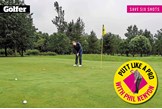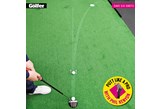Putting coach Phil Kenyon saves you six shots
Published: Last updated:
Phil Kenyon, one golf’s most sought-after putting coaches, shares the seven simple drills that will improve your putting and save you up to six shots per round.
Let me introduce myself. My name is Phil Kenyon and for 20 years I’ve been working as an elite putting coach, offering advice to amateur golfers as well as to superstars such as Rory McIlroy, Brooks Koepka, Justin Rose, Tommy Fleetwood, Henrik Stenson, Francesco Molinari, Lee Westwood and many more.
RELATED: The 100 Most Influential People In Golf

Before beginning my coaching career I completed a Masters Degree in Sport Science and was a professional golfer, playing in tournaments around the world.
In my two-decades as a coach I’ve helped players to more than 70 wins on the PGA Tour and European Tour, including four Major Championships, and have coached at four Ryder Cups.
What this has taught me is that while most handicap golfers might not have the physical attributes to drive the ball 320 yards, anyone can learn to putt like a tour pro, regardless of age, body shape or ability. You just need to know the correct system, drills and advice to put into practice.

In my experience, most amateurs make the same three mistakes which hurt their stroke and kill their score.
The first – and most common – of these is the belief that the stroke should work straight back and straight through. A putting stroke should resemble part of a circle on an incline plane, so don’t fight the fact that the putter is travelling on some form of an arc. Focus more on the face angle being square at impact and starting the ball online.
The second error a lot of golfers make is when they become overly focused on technique and don’t train to perform. Incorporating elements of performance practice is critical to help you transfer the work you do on your technique to the golf course.
The third and final mistake applies to every golfer who believes that putting is an innate ability. That is simply not true. I have helped hundreds of golfers who have progressed from being bad putters to great putters because of their commitment and willingness to improve.
WATCH: Phil Kenyon explains amateur’s three biggest putting mistakes
Most people think they don’t have time to practise, but if you’ve got time to hit balls on the range, you’ve got time to practise your putting. Below you will find seven ‘tour approved’ drills which have been designed to improve your start line and pace control, and teach you how to read greens like a pro. These are the sort of drills that helped catapult Justin Rose from 18th to 3rd in last year’s PGA Tour putting stats.
And the best part is you don’t need to buy expensive equipment or spend hours practising every day to achieve quick and very beneficial results…
RELATED: Best Putting Mats

Putting Drill #1: Hole 100ft-worth of putts
Most golfers would back themselves from inside 5ft, but what about 10ft, 15ft and 20ft? This performance drill is designed to test your green reading and your ability to control your start-line and speed. I consider these three skills key to becoming a great putter and if you can make this assessment a regular part of your routine, you will find it a lot easier to practise with purpose and measure your improvement.
How it works
Pick a hole and hit one 5ft, 10ft, 15ft and 20ft putt using your usual pre-shot routine. Repeat five times to a different hole location, changing the angle of each putt. This will give you a total distance of 250ft from 20 putts in total. Count up your total footage of putts holed and keep a record so you can try and beat it next time. The best score I’ve ever seen is 145ft from Henrik Stenson, but holing 100ft worth of putts is considered PGA Tour winner level.

Putting Drill #2: Take the putting start line test
One of the best tests you can do, regardless of your technical style or approach, is challenging your ability to start the ball on line. If you can’t start the ball on your intended start line, you run the risk of losing consistency and being forced to make compensations with your green reading or speed.
This gate drill is my go-to for helping to develop an accurate start line and is used by all the players I work with on Tour, including Justin Rose, Tommy Fleetwood and Henrik Stenson.
To set it up, you can buy a ready-made device or create your own gate using tees or any straight-edge object lying about the house – for our drill I’ve used two hand sanitiser bottles.
Challenge yourself to hit 10 putts through the gate and keep a note of your miss tendencies to determine what your stroke bias is. The more times you do it, the better your green reading will be due to the feedback becoming more meaningful.
String theory
Find a straight putt and use a string line to help place the gate on your target line. Stick some masking tape on the ground just behind the ball; then using the string align the putter square to the target with the head sitting on the masking tape. Now draw a line using the leading edge of the putter. This will create a perpendicular line to act as a reference to help set-up square.
Ruler test
Use a ruler to make sure the gate is 5cm wide and located 12 inches from the ball and along your start line. This will give you 0.75 degree of error, which I consider to be a good level of accuracy for a club golfer. To put this into the context of a 10ft putt, if you’re start line is just one degree out, you are hitting the edge of the hole [and missing]. Training your aim to become laser-like buys you some stroke error allowance.
RELATED: How Triple Track tech helps you hole more putts

Putting Drill #3: Does your perception match the reality?
A lot of amateurs struggle to start the ball on line because they have a perceptual bias. By that I mean their perception of what appears straight is skewed, and as a result they feel more comfortable by aiming incorrectly.
To find out if you have a perceptual bias, find a straight 10ft putt and use a piece of string or a ruler to draw a straight line from the ball to the middle of the hole.

As you take your normal address, focus on your target line and ask yourself the question: Does my line look straight? If the line looks left or right of the hole, that’s a clear indicator that you have a perceptual bias which is affecting your alignment.
To correct this, try varying your distance from the ball and/or the amount of neck bend until you see straight. If you are right-eye dominant, for example, having your head slightly rotated to the left may give you a better line of sight.
RELATED: Find your perfect putter alignment aid

Putting Drill #4: Simplifying the art of green reading
Green reading is probably the most underappreciated skill you need as a golfer. To learn how to do it effectively, you need to build a repeatable routine to help with your break prediction. This drill is perfect for giving you some structure and is easily transferable from the practice green to the golf course.
Start by picking any hole and then walk around that hole on the radius that the ball is located. Using your intuition and the feel of the ground beneath your feet, identify where the straight putt is. This will be where you feel the transition from walking uphill to downhill and vice versa.
Once you have found your straight putt, place several balls around the hole in a clock position and pay close attention to the journey each ball takes to get to the hole. This will create a memory bank which you can use on the course to work out how much the ball breaks relative to the slope and the angle you are putting across.

Putting Drill #5: See the invisible line
Improving your ability to read greens can take you to levels of performance your stroke alone cannot. I see a lot of amateurs who under-read putts and if you fall into this category, practising with a gate will not only highlight your ability to start the ball on line, but also determine the accuracy of your predicted read.
How it works
Pick a hole and visualise the path the ball is going to take in order for it to go in. Working your way back, place a gate or two tee pegs 5cm apart, 14 inches from the ball, along your start line. This will give you a one-degree margin of error and provide immediate feedback on your predicted read.
If you want really clear feedback, you need to be precise. As you refine your green reading over time, you will intuitively get a better of sense of how different putts will react.

Putting Drill #6: Slow your roll
Pace control in putting is like driving a car. You need to know when to hit the accelerator and when to apply the brakes. This drill trains your adaptability and because you are never hitting the same putt twice, it replicates what happens on the course.
Find a sloping portion of the green and pick two different targets: One at the top of the slope and one at the bottom of the slope. Stick tees or plastic ball markers in the ground 5ft, 10ft and 15ft from each hole [as shown], and then alternate between putting up and down the slope by hitting one putt from each station.
Each time, set yourself a target of how far past the hole you want the ball to finish. For example, it might be keeping the ball within 2ft of the hole when putting down the hill, but only 1ft when putting up the hill.
The aim is to hole the putt or at the very least keep the ball within the zone. If you do that, you can you move on to the next putt. But if you leave your effort short of the hole, you have to go back and hit the previous putt. Whereas,if you hit it past the hole but outside your zone, you simply re-hit the same putt.
We use this drill a lot when preparing for the US Open and the Masters. The idea is that you get punished if you leave anything short. Try to keep score to see how long it takes you to complete the ladder and challenge yourself to beat it next time.
Three steps to train touch
1. Practise varying your intentional speed. Try and hole the same putt using different breaks.
2. Use the ladder drill. Without using a hole, practise hitting a ball one foot past the previous putt.
3. Focus on the time and speed the ball takes to reach the hole, not the mechanics of your stroke.

Putting Drill #7: Matching your intention
The definition of great speed control is your ability to match your intentional speed. When you are constructing a speed drill, I think it’s important to create an intention, such as what speed you want the ball to roll into the hole.
I believe the ability to match your intention is a really important skill – and this drill is perfect for developing touch and feel. Starting with a 3ft putt, use a fake hole or any flat-based object as your target and place three plastic ball markers in the ground, at 1ft, 2ft and 3ft beyond the hole.
- Putt one: Aim for the ball to finish in the first zone, no more than 1ft past the hole.
- Putt two: Aim for the ball to finish in the second zone, between 1ft and 2ft past the hole.
- Putt three: Aim for the ball to finish in the third zone, between 2ft and 3ft past the hole.
Once you’ve hit all three putts, regardless of whether you were successful or not, move back in 1ft, 2ft or 3ft increments and repeat the process until you reach 10ft. The idea is that you are never hitting the same putt twice, so you are always changing your distance and intention.
FREE GIFT: Get your Phil Kenyon putting cheat sheet and videos here
Practice makes perfect
It’s an old saying, but it’s true, so, if you can, try and spend 20-to-30 minutes, three times a week, practising your putting. I know that is still a lot to ask for some people, but if you are serious about your game and improving your handicap, you need to put the time in. You won’t regret it when you see the results.
READ NEXT: The A-Z of Putting
-
 Putting coach Phil Kenyon helps your golf game.
Putting coach Phil Kenyon helps your golf game.
-
 Phil Kenyon works with many of the world's best golfers..
Phil Kenyon works with many of the world's best golfers..
-
 Drill No.1 - Hole 100ft-worth of putts.
Drill No.1 - Hole 100ft-worth of putts.
-
 Drill No.2 - The putting start line test.
Drill No.2 - The putting start line test.
-
 Drill No.2 - Perception and reality.
Drill No.2 - Perception and reality.
-
 Drill No.3 - Perception and reality.
Drill No.3 - Perception and reality.
-
 Drill No.4 - Simplifying green reading.
Drill No.4 - Simplifying green reading.
-
 Drill No.5 - See the invisible putting line.
Drill No.5 - See the invisible putting line.
-
 Drill No.6 - Slow your roll.
Drill No.6 - Slow your roll.
-
 Drill No.7 - Matching your intention.
Drill No.7 - Matching your intention.
-
 Putting coach Phil Kenyon.
Putting coach Phil Kenyon.
